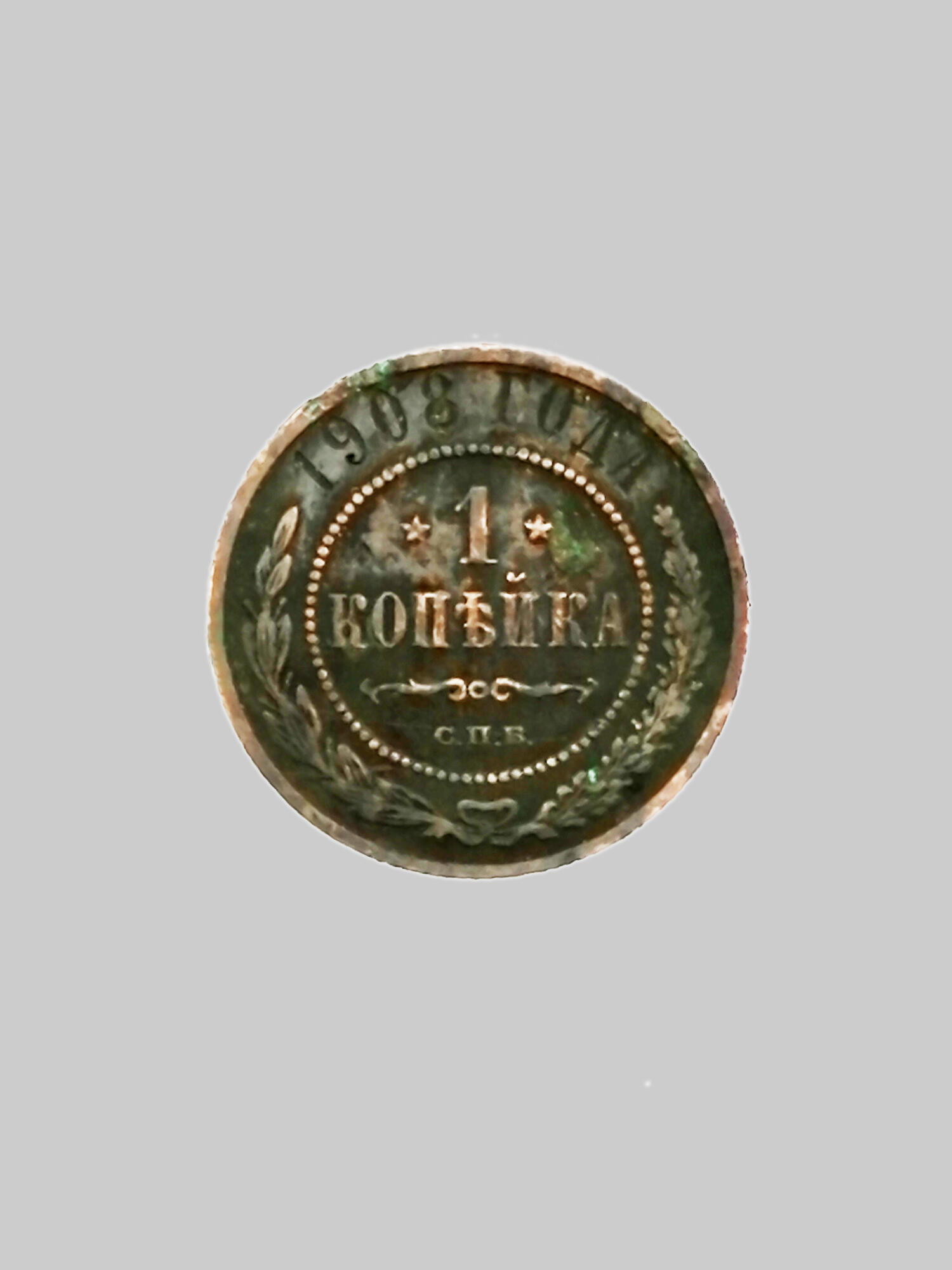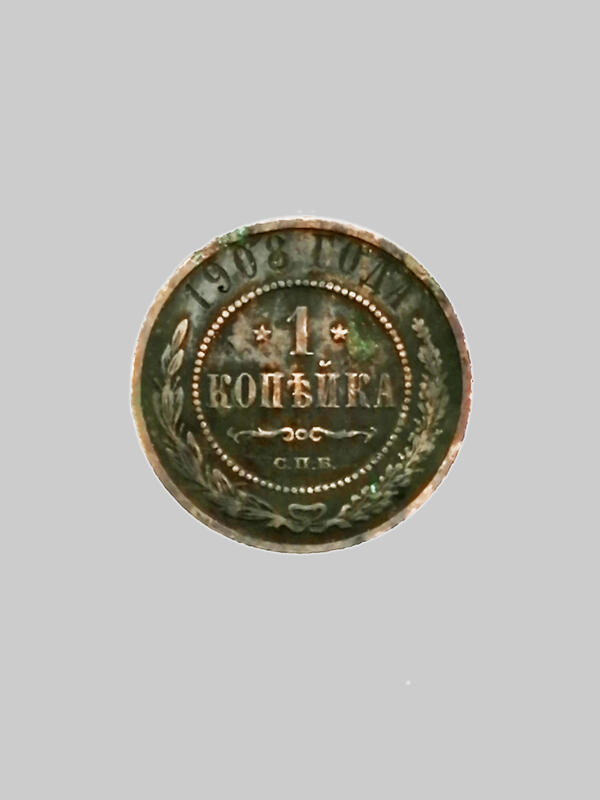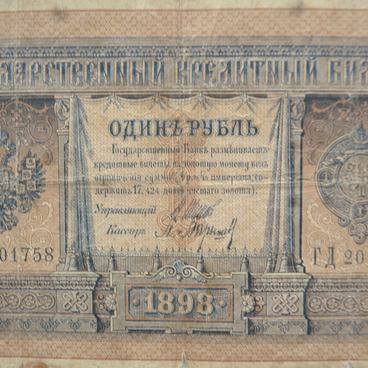The numismatic collection of the Karasuksky Regional Museum includes a solid copper coin, with a face value of one kopek. It was minted at the Saint Petersburg Mint in 1908, during the reign of Nicholas II, the last Tsar in the Romanov dynasty.
The small State coat of arms from 1883 is displayed on the coin’s obverse. This coat of arms depicts a two-headed eagle under three crowns, with an orb and scepter. The eagle’s chest displays Moscow’s coat of arts, surrounded by a chain with the symbol of Saint Andrew. Additional coats of arms are positioned on the eagle’s wings: The Khanate of Khan, the Congress Poland, Chersoneses, the Astrakhan Khanate, the Khanate of Sibir, the Kingdom of Georgia and a coat of arms formed of the principalities of Kiev, Novgorod and Vladimir. A semicircle around the eagle is formed of geometric patterns. In the upper half of the coin, a raised inscription reads: ‘RUSSIAN COPPER COIN’. In the lower half of the coin, there is a depressed inscription, reading: ‘ONE KOPEK’.
On the coin’s reverse there is a two-line inscription, reading “1 KOPEK”. Beneath a decorative pattern, the small letters of “S.P.B” are displayed - standing for the Saint Petersburg Mint. There is an arched depressed inscription at the top of the coin, reading: “1908”. The coin’s rim or edge is corded, meaning that it is formed of equally spaced vertical cuts.
Between 1867 and 1917, copper coins were minted at the mints in Yekaterinburg (with the designation EM) and Saint Petersburg (with the designation SPB, or without any designation). There were also minted in Great Britain, at the mint in Birmingham, whilst the Saint Petersburg mint was shut for repairs and refurbishment between 1896 and 1898. The Rosencrantz factory was also used between 1899 and 1900. The designation for these coins remained the same: ‘S.P.B.’ The coins were minted at a ratio of 50 rubles from a pood (16.3 kilograms) of copper, or 50,000 kopeks. Until 1867, the coin to metal ratio had been 32 rubles from a pood of copper, making the coins significantly heavier.
According to the catalogue ‘Russian Coins 1700-1917’, the museum’s coin is a design that was widely used throughout the nation and regularly issued. It corresponds with the type of coins minted at the Saint Petersburg mint between 1867 and 1917. The overall circulation of this design of kopek amounted to 40 million coins, all weighing 3.28 grams.
The small State coat of arms from 1883 is displayed on the coin’s obverse. This coat of arms depicts a two-headed eagle under three crowns, with an orb and scepter. The eagle’s chest displays Moscow’s coat of arts, surrounded by a chain with the symbol of Saint Andrew. Additional coats of arms are positioned on the eagle’s wings: The Khanate of Khan, the Congress Poland, Chersoneses, the Astrakhan Khanate, the Khanate of Sibir, the Kingdom of Georgia and a coat of arms formed of the principalities of Kiev, Novgorod and Vladimir. A semicircle around the eagle is formed of geometric patterns. In the upper half of the coin, a raised inscription reads: ‘RUSSIAN COPPER COIN’. In the lower half of the coin, there is a depressed inscription, reading: ‘ONE KOPEK’.
On the coin’s reverse there is a two-line inscription, reading “1 KOPEK”. Beneath a decorative pattern, the small letters of “S.P.B” are displayed - standing for the Saint Petersburg Mint. There is an arched depressed inscription at the top of the coin, reading: “1908”. The coin’s rim or edge is corded, meaning that it is formed of equally spaced vertical cuts.
Between 1867 and 1917, copper coins were minted at the mints in Yekaterinburg (with the designation EM) and Saint Petersburg (with the designation SPB, or without any designation). There were also minted in Great Britain, at the mint in Birmingham, whilst the Saint Petersburg mint was shut for repairs and refurbishment between 1896 and 1898. The Rosencrantz factory was also used between 1899 and 1900. The designation for these coins remained the same: ‘S.P.B.’ The coins were minted at a ratio of 50 rubles from a pood (16.3 kilograms) of copper, or 50,000 kopeks. Until 1867, the coin to metal ratio had been 32 rubles from a pood of copper, making the coins significantly heavier.
According to the catalogue ‘Russian Coins 1700-1917’, the museum’s coin is a design that was widely used throughout the nation and regularly issued. It corresponds with the type of coins minted at the Saint Petersburg mint between 1867 and 1917. The overall circulation of this design of kopek amounted to 40 million coins, all weighing 3.28 grams.


